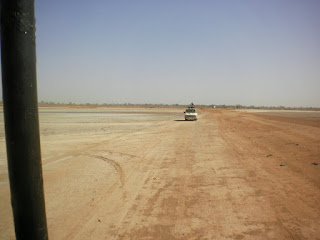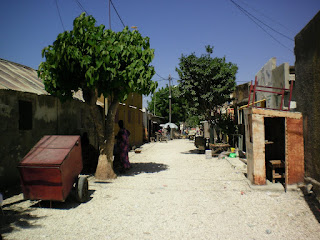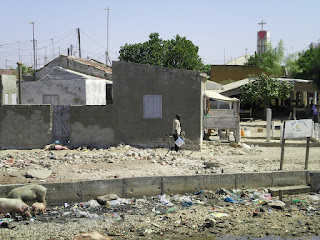Sunday, January 27,
2013
Senegal, It’s Like a
Foreign Country
We’ve been in Dakar, Senegal for three full days plus the Thursday afternoon/evening we arrived. It’s like being in a foreign country,
really. They speak foreign languages
(only), Wolof and French, they use strange money, the CFA (…franc) which is
used by 7 West African nations, and they eat food and drinks we have never
had. Overall, it’s challenging and lots
of fun.
On arriving at the airport, we discovered that I had written
the wrong phone number for our B&B and we could not find the fellow from the
B&B, Ishmael, who was supposed to be waiting for us. Many cab drivers offered to take us where we
were going, one fellow pressured us to buy a phone SIM card from him (we did),
offered to help us, offered to take us by cab to an Cyber café, and that’s when
we decided to try something else. It all
got sorted out in about half an hour when we finally found a security guard at the
airport who would let us use his laptop to find the website and phone number of
our B&B. A phone call or two confirmed that Ishmael was
there but we were looking for him in the wrong place. Not a great way to start but live and learn.
Well, the learn part comes hard for us apparently. Next morning, Friday, our first full day in Dakar, we walked to the beach about
half a mile away and got thoroughly lost when we figured we could get back on that
road right next to the one we got there on.
Oops! When we finally figured out
that we would never find our way home alone, we hailed a cab, showed him the
address and he proceeded to drive around for 15 minutes looking for the house,
never finding it. We were always within ½
mile. We got him to stop when we
realized he was never going to find the place.
We then walked in circles a bit, looking for a familiar landmark, and we
found many – everything looked the same.
A second cab driver had about as much luck as the first. Of course, he assured us that he could find
the place, but he never did. We finally
got to the B&B when the owner’s son, Jonathan, talked to the cabbie on the
phone (for the third time) and determined where he was. He told him to stay there while he ran to
meet him. He ran, but the cabbie figured
that he knew where he was going, so he went on.
Five minutes later, by chance, Jonathan saw the cabbie stop in an
intersection of the very narrow streets and he almost tackled the cab on the run. We were saved.
That afternoon, we took a 4 hour driving tour of Dakar with
Ishmael as our driver and Sineta George, the owner of the B&B, as our
guide. Dakar is a big place with far less poverty showing than Kenya, even,
Nairobi. There are some amazing
monuments and buildings that we will have to explore in the coming week. There is even a brand new three-story
underground mall which Sineta took us to - complete with bowling alleys. We will skip the mall when we are on our own.
I guess I lied when I said everybody speaks only Wolof or
French. Ishmael speaks self-taught
English (quite well, actually) and Sineta is from Florida originally. She and Jonathan, her 16 year old son, speak
English. Jonathan and Ishmael have
turned out to be very valuable to us because they both speak Wolof and French
as well as English. Although Sineta has
lived in Senegal for 14 years, her French and Wolof are limited.
On Saturday we
took drumming lessons in a place in town called N’Gor, on the shore. Sixteen folks drummed for just about two
hours under the tutelage of Ibo. All but
three of us used djembes. Sandy was on a
djembe and I had a bougarabou. They look
and sound pretty much the same. We were
both great, of course.
We had lunch at N’Gor as part of the drumming class
experience; then we took a cab to a huge new monument celebrating the renaissance
of Africa. It was fabulous. The three figures, man, woman, and child, are
made of copper (over a superstructure) and stand 52 meters above a steel and
concrete base which is on summit of a rock some 198 steps above the surrounding
hill. It’s a long way to the top! The museum inside the steel and concrete base
had many works of art and exhibits celebrating the contributions of black men
and women to civilization and society from the dawn of man until today. This is a monument well worth seeing.
We did not get lost on Saturday. We ate dinner at a small local halal restaurant
close to our B&B. Lunch was good.
Today, Sunday, we
did not get lost again. We went to the
island of Goree, about ½ mile off the southern coast of Dakar. The island is known most as a former slave
debarkation point from Senegal as slaves were sent across the Atlantic to the Caribbean
and Americas and to Europe. We have seen
a similar, though larger place in Zanzibar, and both gave us an uneasy feeling,
to say the least.
On a brighter note, Goree is an artist colony as well as a
place full of folks trying to sell just about anything from wood carvings to
jewelry, to fabric and clothing, to paintings.
There’s a lot of junk that makes the good stuff hard to find. But find some we did – not for sale - an
exhibit of commissioned sculptures, installations, and photographs celebrating
progress of Africans from slavery to modern times, right there on Goree. We have never seen art or spirit like this in
Kenya that we can recall. Africa is not
the same all over.
Tomorrow, Monday,
we are off on a “collective” (taxi, sort of) to the mangrove swamps just north
of The Gambia if all goes well.

























































